The ‘season’ begins.
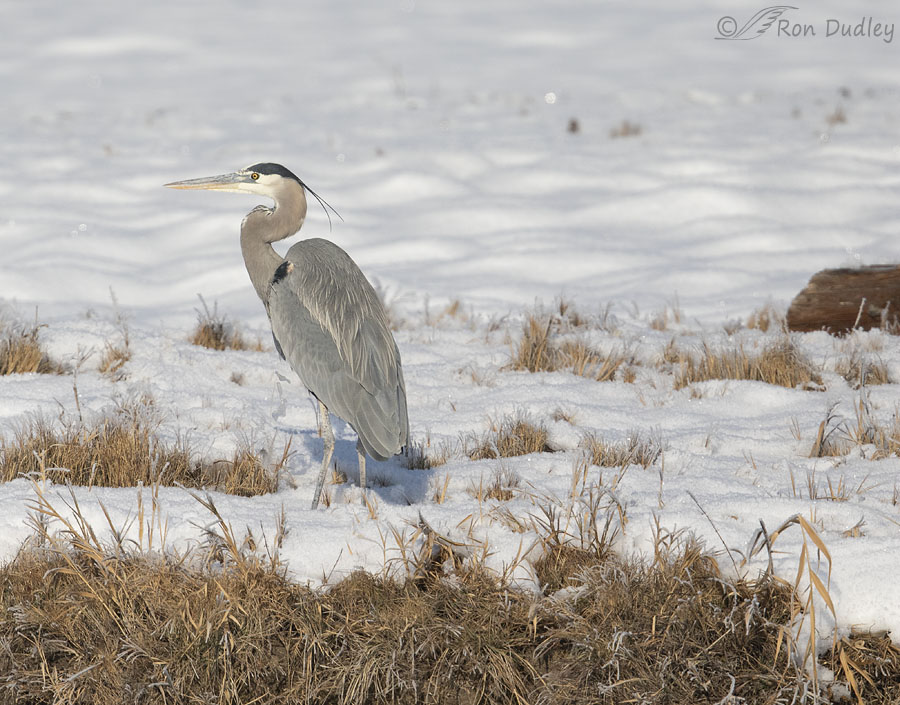
Two days ago this Great Blue Heron was standing in the snow next to the Bear River in Box Elder County. I’ve cropped this photo weirdly for two reasons – to show the end of the large log on the right edge of the frame and to show the vegetation along the river’s edge at bottom. The river itself is only a few inches below the bottom of the frame.
After taking quite a few photos of the heron I decided to shoot a few photos vertically in order to include part of the river in the frame. But very soon after I reacquired focus on the heron ‘he’ decided to jump-fly over to the log on the right and use it as a perch. Maybe his feet were getting cold in the snow.
Bad timing. While he was moving to the log with his wings out while I was shooting vertically I couldn’t keep his huge wings completely in the frame.
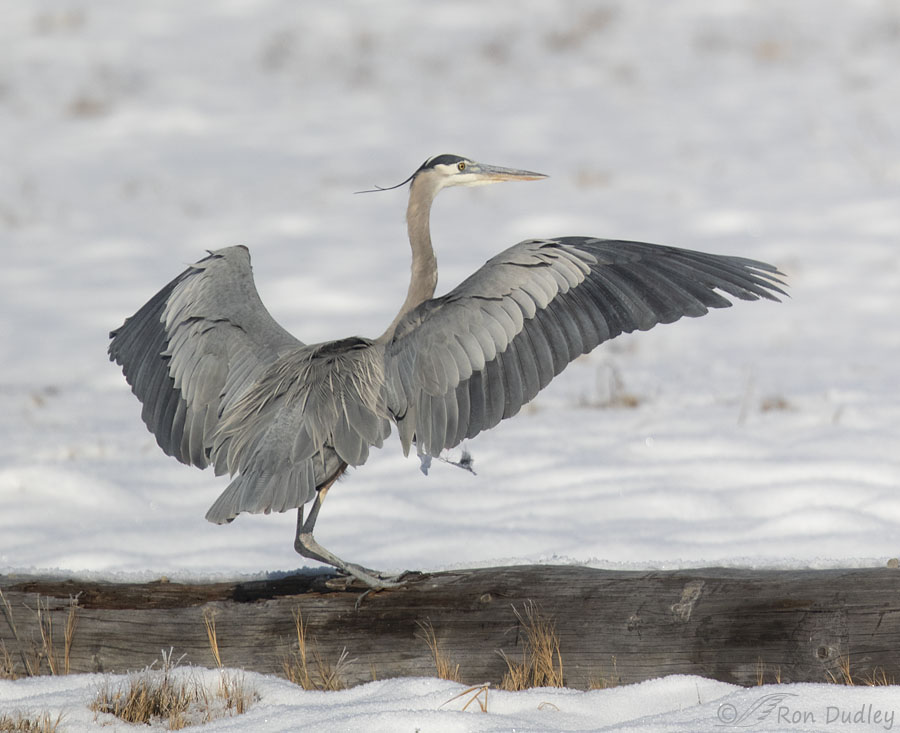
I succeeded only one time while he still had his wings out after jumping up onto the log. But because I was shooting vertically this crop also has a less than ideal composition because I didn’t have any more room on the right. I still like the photo.
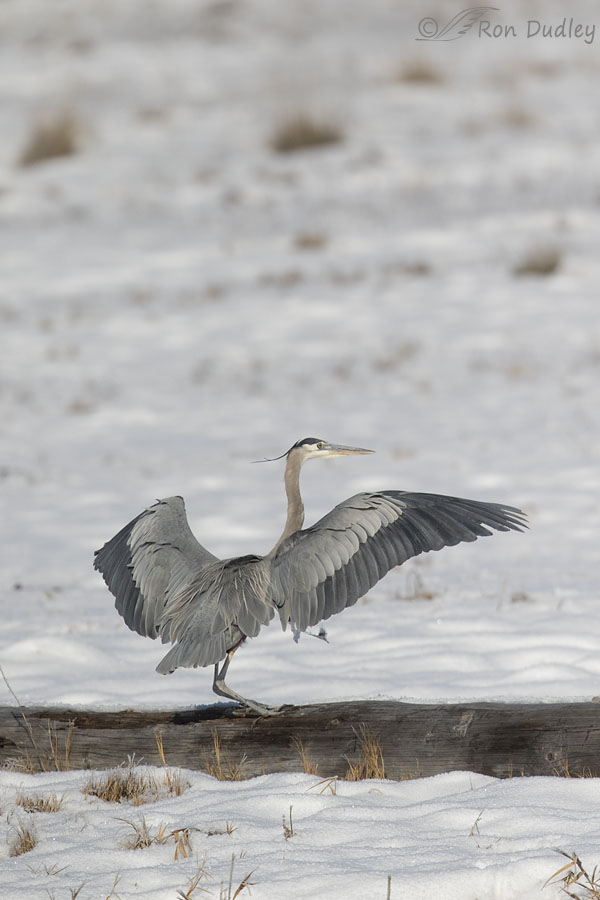
Here’s the full frame (uncropped) version of the image to show you what I had to work with. After switching to vertical shooting I never did get any photos that included any of the river.
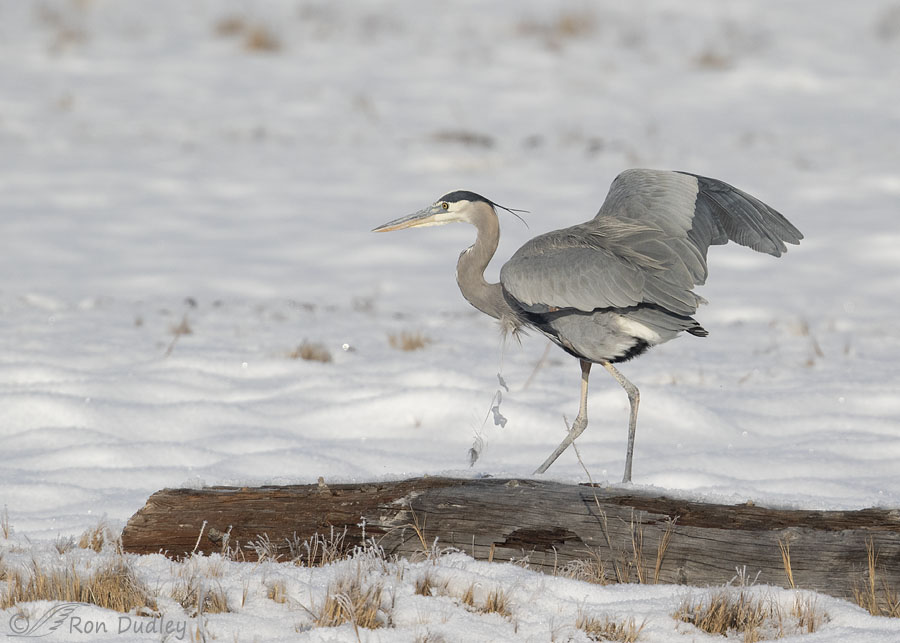
Soon after landing on the log he began to walk to the west end of it. By now you’re probably noticing that there’s something hanging down from the plumes (unusually long feathers) on his lower neck. At first I considered the possibility that it was fishing gear and line but it turned out to be…
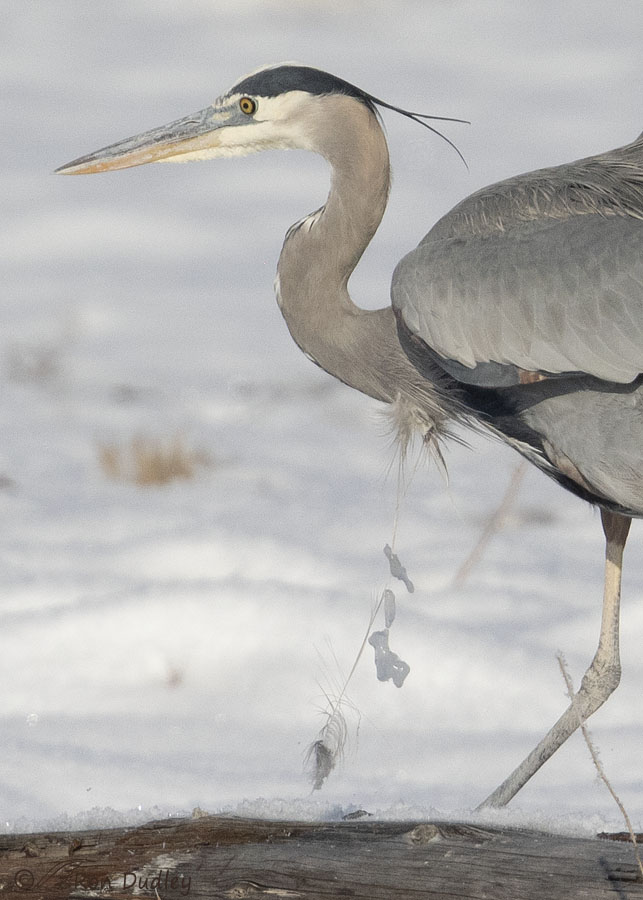
ice.
In freezing temperatures icy plumes are almost inevitable when herons are standing in shallow water while fishing. When they strike out after a fish their very long plumes get wet and when the bird stands erect again those plumes freeze in the frigid air. After repeated strikes thick ice can build up.
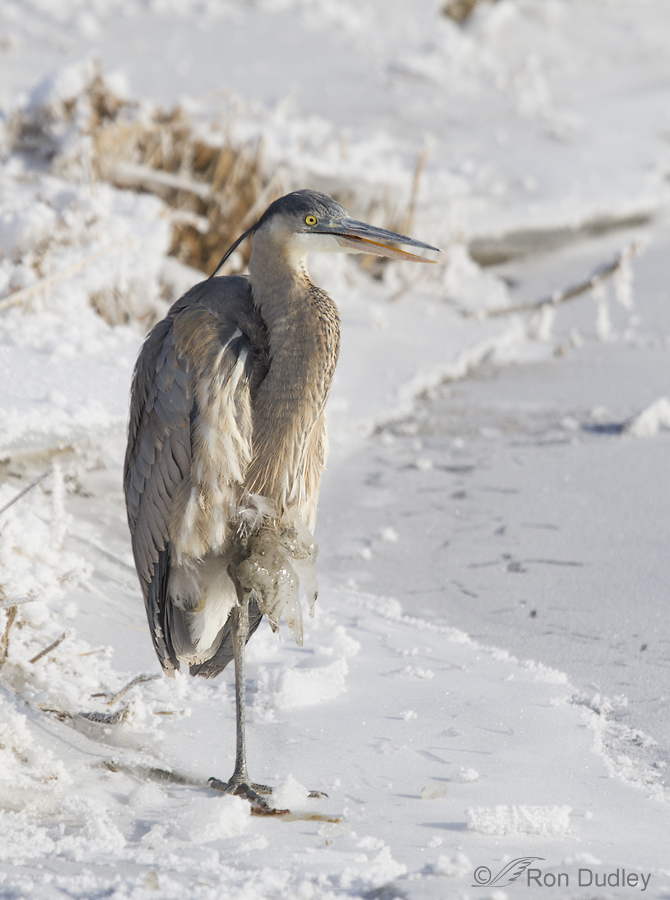
Here’s an older (and poorly processed) photo of a Great Blue Heron at Farmington Bay WMA that has a significant ice-buildup problem on its plumes.
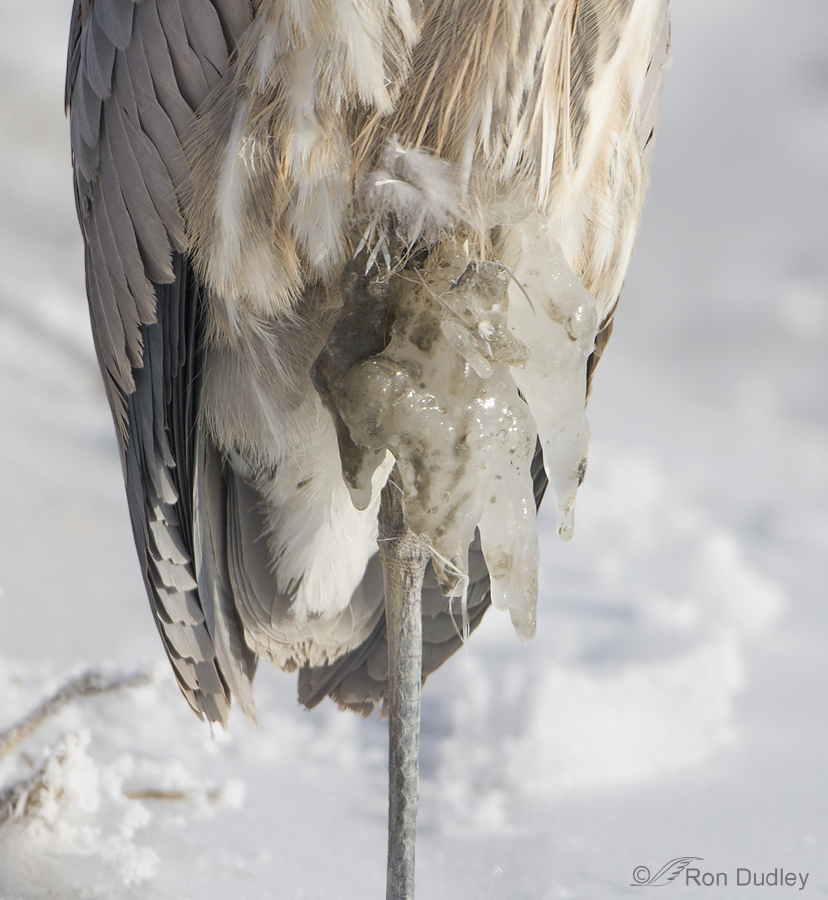
The poor bird probably had difficulty flying with that heavy chunk of ice flopping around. Assuming our cold weather continues, herons with icy plumes will probably be the rule rather than the exception through the beginning of February.
For many of my readers I suspect seeing Great Blue Herons in snow and on ice, including with icy plumes, seems a little incongruous but around here it isn’t the least bit unusual.
Ron


Looking at the first GBH I was humorously going to suggest that the icy plumes were xmas decorations but after seeing the chunks on the second Great Blue Heron I was thinking of the mafia and concrete shoes. New and old photos: the treasures of a dedicated and very observant photographer.
“the mafia and concrete shoes”
Dammit, I wish I’d thought of that for my post! I might have to hire you as a creative consultant, Lyle.
An excellent plan! 😂
I’m very late commenting, but this is an amazing post! The photos are gorgeous, of course (the bird’s colors are just the best). But the info about their icy plumes makes this super-special. I knew about the ruffly feathers on their breasts, but had no idea they had those long dangling plumes too. At first look, I thought fishing line and thought the story would be awful. Whew, ice, at least, might melt.
Thank you, Carolyn. At first I was afraid it might be fishing line too.
The poor, ice-logged GBHs. I wish there was a way to knit a little muffler for them (of course, the muffler would get wet and ice over too).
Seeing those wings spread is really something! They are definitely cool birds! (In this case, very cool, unfortunately.)
We’re getting some much-needed rain here. The moat is back, but the back of the house hasn’t floated away yet.
Thanks, Marty. Enjoy your rain. It’s about time for CA to get some. We’ve actually had some rain today too.
Yikes! Like having a shoelace untied. Watch your step, GBH! Thanks for the terrific series, Ron.
You’re very welcome, Ellen.
I’ve never seen this before. Wow! GBH and GWH are very prevalent in Louisiana but ice isn’t. 😀 Now that I am in New Mexico, I see the GBH but I don’t get close enough to stare at their chest! :O lolololol
😊
Wonderful photos (I especially like #4), but oy! I am feeling what I imagine must be those poor herons’ pain — the recent bird will possibly be looking like the older one in short order now that winter has apparently arrived in earnest. 🥶 SoCal weather (rain, glorious rain!) would not be nearly so hard on those feet, legs and chest plumes, however.
Chris, I’ve been reading about all the rain (and snow in the mtns) CA is supposed to get, and is getting. Time to grow gills I guess. And/or snowshoes.
It’s been pouring all day and, other than going out to give the waterlogged birdies fresh sustenance, I’m staying warm & cozy inside ‘til Saturday! 🎄
Good. It’s raining here tonight too.
It always make me wonder how the lingering pelicans don’t totally ice up since they spend so much time in and out of water. I guess that is why when they are out of water they spend so much time preening the water out of the chest and stomach feathers.
Could be, April. As you probably know there was a “lingering pelican” close to this heron at the same time.
Majestic and marvellous = despite the frozen plumes. Which must get heavy and uncomfortable. Birds are tough. They need to be.
EC, I’ll bet the ice chunk in the last photos weighs just about as much as the bird. Water (ice) is heavy, birds are very light for their size.
PS: It is shortly after three this morning and already hotter than I like. Very shortly now I will be turning to your photos for cool relief (as well as education and beauty).
Slam your head into your pillow! It’s way past time. If you ask me (which you didn’t) you need sleep more than you need cool.
I have had some sleep (though never enough). And sleeping is an issue when it is too bloody hot as well.
Who knew?! The weight of the ice alone must be problematic for the herons. They are tough!!
Tough indeed.
GBH are definitely a “summer bird” here. Neat shots. 🙂 Ice build up, even in small amounts certainly could be a problem let alone the amount on that poor bird in the older picture. Like him on the log and “walking the plank” so to speak.
Our relatively warm/windy weather is about to come to a screeching halt in the next day or so going zero to sub-zero and, probably, through the new year…… ” Tis the season” BUT not looking forward to it.
I’ve only seen them in summer in MT too, Judy – including on the farm.
Based on what you said I’m sure glad I won’t be in Cut Bank anytime soon.
Wow, fascinating. I never would have imagined that! Thank you.
Glad you enjoyed it, Ann.
I guess one is never too old to learn something new. Ice photos are in that category. Amazing pics.
Thanks, Bob.
Very interesting series Ron. I have often taken photos of our Herons in the winter, but have never witnessed the iced plumes. Of course our winter temperatures are much warmer than yours. I have seen parts of our lakes frozen over, but never an entire lake. The Herons and Egrets etc always have some open water to fish in. Good photos to illustrate the problem. As strong as Herons are that amount of ice could definitely be a problem trying to take off. Thanks for posting.
Everett, here in northern Utah we’re at right about the edge of their winter range. North of here most of them migrate south for the winter.
However, some actually winter in coastal Alaska (as my friend Jim DeWitt pointed out to me). Tough birds!
Fabulous shots with great detail. Can’t help but feel sorry for the GBH; that has got to be one cold bird.
I’m sure he was, Granny Pat. I was cold and I was in my pickup.
I’ve never seen such a thing, even in photos. After looking at your images, I think I’ll worry a bit less about our Great Blue Herons when the temperature drops below freezing and they take shelter on the swim platforms of boats or seem insistent on fishing despite it all!
These herons are tough, Shoreacres. During unusually cold winters when ALL standing water freezes so they can’t fish, our herons switch over to hunting voles – usually in the snow. To see a heron with a bloody vole or other small mammal in its bill gets your attention.
Yikes! I often wondered how they dealth with frozen temps to feed!! Thx for the show and tell.
Kind of makes one cold just to look at the photos doesn’t it, Terri.